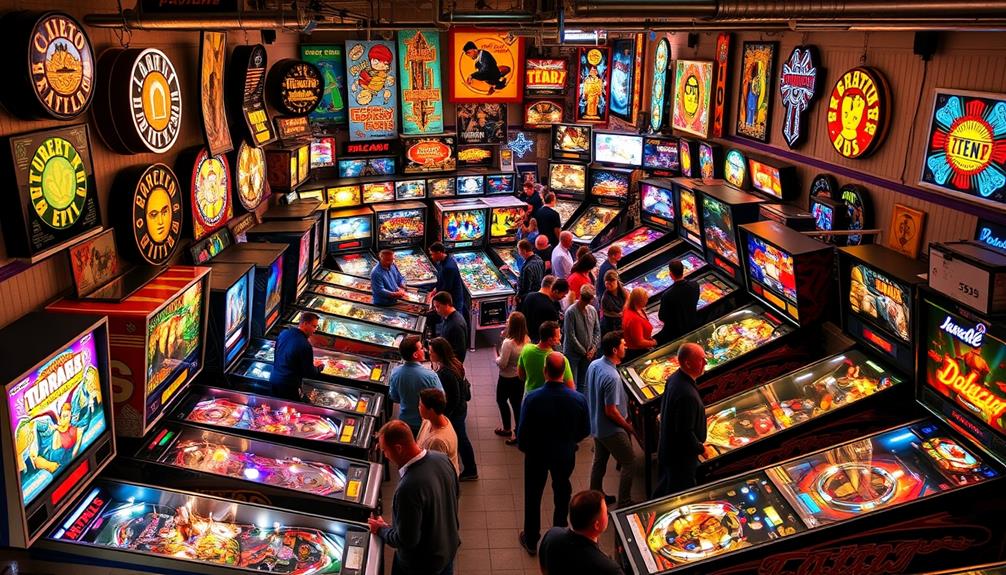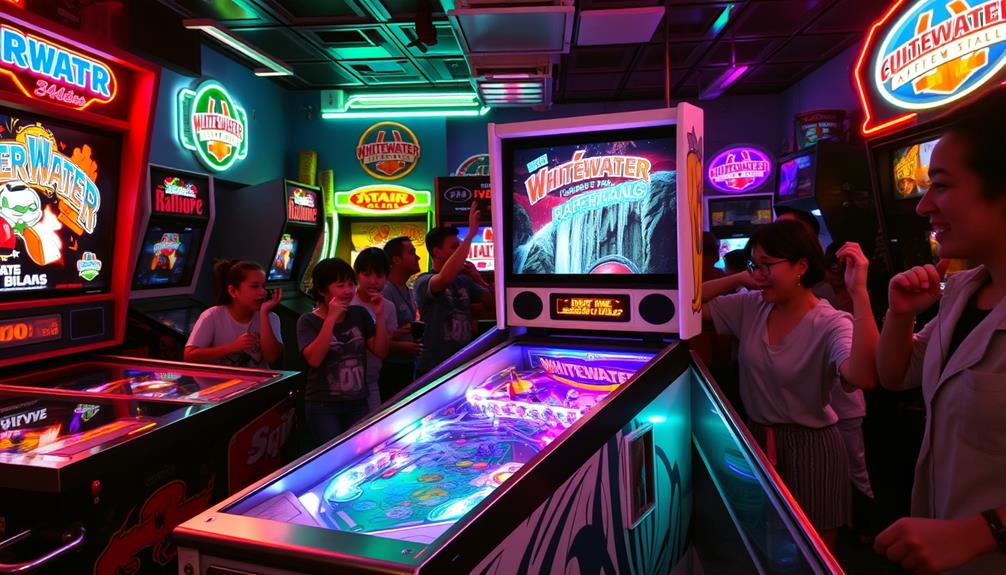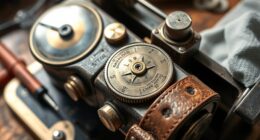Pinball machines can come with a hefty price tag due to a variety of factors. Initially, the high costs of obtaining licenses for themed games are transferred to consumers, resulting in an increase in retail prices. Additionally, the elaborate artistic design and complexity of these machines require skilled artists and top-notch materials. The mechanical components and intricate wiring also necessitate costly craftsmanship. Machines with unique ramps or features contribute to the overall expenses. Lastly, the popularity and demand for limited edition models drive prices even higher. Interested in learning more about the specific aspects that impact these costs? There’s much more to delve into!
Translation:
Pinball machines can be expensive because of several key factors. First, high licensing fees for themed games get passed on to you, increasing the retail price. Then there’s the artistic design and complexity, which require talented artists and high-quality materials. Mechanical components and intricate wiring also demand expensive craftsmanship. If a machine has unique ramps or features, that adds even more to the cost. Finally, the collectability and demand for limited edition models further inflate prices. Curious about the specific elements that contribute to these costs? There’s plenty more to explore!
Key Takeaways
- Themed pinball machines incur high licensing fees, which significantly increase manufacturing costs passed on to consumers.
- Artistic design and the use of high-quality materials contribute to the overall expense of pinball machines.
- Complex mechanical components and electronic circuitry require precise design, testing, and skilled labor, raising production costs.
- Unique ramps and custom features enhance gameplay but necessitate specialized tooling and extensive planning, increasing overall expenses.
- Durable materials and craftsmanship ensure longevity, but also elevate the initial production costs of pinball machines.
Licensing Fees for Themed Games
Exploring the world of pinball machines, you'll quickly notice that many feature themes from popular movies, TV shows, or bands. These themes aren't just for flair; they come with significant costs, often requiring manufacturers to evaluate various gold investment strategies that could help offset expenses.
Manufacturers need to secure licenses for these themed games, and that often means entering complex negotiations. Licensing fees for themed games can soar into six figures, dramatically affecting overall manufacturing expenses.
When you look at popular titles, you might notice that their retail prices reflect these added costs. The high licensing fees are passed down to you, the consumer, making these machines not just a fun investment but a costly one as well.
Additionally, the licensing process goes beyond just paying for rights; it often requires a hefty investment in marketing and promotional efforts to effectively align with the licensed brand.
This necessity to pay for licenses contributes to the high initial investment and production expenses associated with pinball machines.
Artistic Design and Complexity

The enchanting visuals of pinball machines draw players in, thanks to the skillful artistry that adorns both the playfield and the machine's exterior. This artistic design plays a vital role in elevating the overall gaming experience.
However, the beauty you see isn't just skin deep; it reflects a significant complexity in both planning and execution. The attention to detail in the design can be likened to the meticulous crafting of essential oils, where every ingredient is chosen for its unique benefits, such as essential oils for respiratory health.
Consider these key factors that contribute to the costs:
- Talented Artists: Skilled professionals create unique and engaging artwork, which enhances the game's visual appeal.
- Extensive Planning: Each design requires thoughtful consideration to guarantee it complements the gameplay, blending creativity and engineering.
- High-Quality Materials: Intricate details demand premium materials, which drive up production costs.
- Advanced Manufacturing Techniques: The complexity in design necessitates modern processes, further increasing expenses.
This combination of artistic design and complexity means that manufacturers invest heavily in both the creative and technical aspects of game development.
As a result, the final product isn't just a machine; it's a piece of art that reflects craftsmanship, creativity, and innovation, justifying the higher price tag.
Mechanical Components and Circuitry

When you consider the cost of pinball machines, you'll notice that quality components play an essential role in their durability and performance.
This is similar to the importance of preventive maintenance plans for appliances, which can greatly extend their lifespan.
The complex electronic circuitry also adds to the expense, as it requires precise design and testing to guarantee everything runs smoothly.
Together, these factors greatly impact the overall price of the machine.
Quality Component Durability
Quality component durability in pinball machines plays a significant role in their overall performance and longevity.
When you reflect on the factors that contribute to pinball machines cost, the quality of the mechanical components stands out. High-quality materials guarantee these parts can withstand countless games without malfunctioning, which is vital for player satisfaction.
Additionally, regular maintenance of these components can enhance their lifespan and performance, similar to how proper cold medications usage can lead to effective relief.
Here are four key aspects to take into account:
- Mechanical Components: Flippers, ramps, and pop bumpers are designed with durability in mind, but using superior materials increases production costs.
- Custom Features: Unique mechanical elements tailored for specific games require specialized tooling, adding to the overall expenses.
- Labor-Intensive Assembly: Skilled workers are needed for the meticulous installation of both mechanical and electronic parts, driving up labor costs.
- Long-Term Reliability: Investing in durable components means fewer repairs and replacements, ultimately saving money for operators in the long run.
Complex Electronic Circuitry
Durability in mechanical components sets the stage for the intricate world of electronic circuitry in pinball machines. The complex electronic systems not only control gameplay but also demand a high level of design, production, and testing.
Understanding common financial terms can also help potential buyers make informed decisions regarding their investments in these entertainment pieces. This notable effort contributes heavily to the overall pinball cost.
The circuit boards used are sophisticated and costly to manufacture, reflecting the advanced technology in modern machines. You'll notice that high-quality mechanical parts like flippers and ramps are essential for performance and longevity. This quality requirement further inflates production expenses.
Additionally, the extensive wiring systems in each pinball machine are often hand-assembled, making the assembly process labor-intensive. This meticulous attention to detail increases the manufacturing costs considerably.
Ultimately, the combination of advanced electronic components and durable mechanical parts creates a seamless gaming experience. However, this complexity and quality directly influence the pricing of pinball machines, driving up the pinball cost.
When you invest in a pinball machine, you're not just buying a game; you're purchasing a piece of intricate craftsmanship that melds technology with entertainment.
Unique Ramps and Features

When you consider unique ramps and features in pinball machines, you'll notice that custom components can greatly raise production costs.
The intricate design and specialized parts are comparable to the trusted reputation in the financial services sector of companies like Fidelity Precious Metals IRA.
These specialized elements not only enhance gameplay but also make each machine more valuable in the market.
The investment in design and manufacturing reflects in the overall price you see when shopping for these exciting games.
Custom Component Production Costs
Creating custom components like unique ramps and features for pinball machines can dramatically increase production costs. These specialized parts require unique tooling and manufacturing processes, which contribute to the overall expenses. This complexity is similar to the iterative prototyping seen in design thinking methodologies, where understanding user needs drives innovation.
Here's a breakdown of how custom component production costs can add up:
- Specialized Tooling: The costs of creating tools can range from $2,000 to $20,000, depending on complexity.
- Labor Expenses: Extensive planning and skilled labor are essential for designing and producing these components, driving up costs.
- Material Costs: High-quality materials are often necessary to guarantee durability and performance, which increases expenses further.
- Complexity of Features: Each unique feature enhances gameplay but also complicates the manufacturing process, adding to the overall production costs.
When you consider the integration of unique playfield toys and mechanisms, it becomes clear how these elements differentiate machines and influence the final retail price.
Ultimately, the investment in custom components not only elevates the gaming experience but also considerably raises the cost to produce each pinball machine.
Gameplay Enhancement Features
Gameplay enhancement features, such as unique ramps and playfield toys, transform the pinball experience into something truly special. When you play, these intricately designed elements not only add excitement but also challenge your skills.
Each game's playfield is tailored, often requiring significant investment in custom tooling and manufacturing processes. This customization reflects the same creativity seen in Star Wars prom escorts, showcasing the cultural impact on personal expression.
This customization isn't cheap; tooling costs for creating unique parts can range from $2,000 to $20,000. Such expenses contribute to the overall cost of the machine, as manufacturers must invest heavily in specialized components.
The incorporation of playfield mechanisms and toys enhances gameplay complexity, which in turn drives up production costs. These distinctive features play a vital role in engaging players and differentiating machines in a competitive market.
When you're captivated by an innovative ramp or a clever playfield toy, it justifies the higher price tag. The craftsmanship involved in designing and producing these gameplay enhancements reflects the passion behind pinball machines.
Ultimately, the unique ramps and features you encounter aren't just for show; they're integral to the pinball experience, influencing both enjoyment and the machine's retail price.
Extensive Wiring and Assembly

Building pinball machines involves tackling extensive wiring and assembly challenges that can greatly drive up production costs. The intricate wiring connects various mechanical and electronic components, which contributes to the complexity of the production process.
Additionally, the craftsmanship involved can evoke feelings of nostalgia and joy, reminiscent of the vibrant experiences found in Blue Skies and Lemonade. Here are some key factors to reflect on:
- Hand Assembly: Most wiring is done by hand, making the assembly labor-intensive and increasing labor costs.
- Wire Harnesses and Plugs: These are essential for the machines' functionality, adding to the overall expense of production.
- Advanced Features: Incorporating advanced features increases the complexity of wiring systems, elevating manufacturing challenges and costs.
- Skilled Professionals: Effective wire management often requires hiring skilled professionals, further adding to the assembly expenses.
These elements combined illustrate why extensive wiring plays a significant role in the overall cost of pinball machines.
The labor and expertise involved in ensuring everything works seamlessly aren't just time-consuming; they also make the production of these machines a more expensive endeavor.
Material Costs and Cabinet Construction

The intricate wiring and assembly of pinball machines set the stage for understanding the significant material costs and cabinet construction involved in their production.
When you look at a pinball machine, realize that the cabinet alone can cost around $300 to produce. This expense reflects the high-quality wood and components essential for durability and functionality. After all, the cabinet must endure the rigors of gameplay and transport.
Additionally, the precision required in the cabinet's construction is similar to the attention to detail needed in creating a home cinema, where selecting the right projector type is vital for ideal performance.
In addition to the materials used, artwork design adds another layer of expense. You're looking at around $10 to $15 per machine for eye-catching graphics that enhance the overall aesthetic.
Furthermore, advanced manufacturing techniques, like CNC machining, are vital for precise component placement in the cabinet, which drives up tooling costs.
The integration of unique mechanical and electronic components tailored specifically for each machine further elevates production costs.
All these factors combined illustrate why material costs play a pivotal role in the pricing of pinball machines.
Collectability and Limited Production

When it comes to pinball machines, scarcity is a key factor that drives their value.
You might find that limited edition models, with their unique designs, can fetch impressive prices due to their rarity and collectors' desire.
Plus, the nostalgia tied to these machines makes them even more appealing, as many enthusiasts cherish the memories associated with specific games.
Scarcity Drives Value
Scarcity fuels the fascination with pinball machines, turning them into coveted collectibles for enthusiasts. The limited production runs create a sense of exclusivity, and that drives their market value up.
Here's how scarcity impacts your potential collection:
- Limited Availability: Rare machines, especially older models, often sell for much more than their original retail price due to their scarcity.
- High Demand: Limited edition models frequently sell out quickly, leading to inflated resale prices as collectors scramble to secure them.
- Increased Interest: The resurgence of retro and classic arcade games has amplified the collectability of pinball machines, making them even more sought after.
- Unique Themes: Collectors prioritize unique themes or features, leading to heightened competition and, subsequently, higher prices.
When you understand how scarcity drives value, you can appreciate why some pinball machines fetch astronomical prices. It's not just about the game itself; it's about owning a piece of history that few others can claim.
Nostalgia and Sentimentality
For many collectors, pinball machines aren't just games; they're gateways to cherished memories of youth spent in buzzing arcades. This deep nostalgia fuels a sentimental attachment that drives many enthusiasts to pay premium prices. When you think about those joyful moments spent flipping flippers and racking up scores, it's no surprise that specific titles resonate more deeply, enhancing their value in your eyes.
Limited production runs of certain themed machines add to their allure, creating a sense of exclusivity that appeals to collectors. You might find that older machines, especially those featuring iconic themes or unique designs, can command considerably higher prices than their original retail values. This is largely due to the emotional connections you and many others have with these machines, making nostalgia a powerful motivator in the pinball market.
Collectors often prioritize sentimental value over monetary worth, which means you're not just buying a game; you're investing in a piece of your past. As you seek to relive those experiences, the willingness to spend more on machines that hold personal significance becomes clear, further driving up prices in this niche market.
Limited Edition Appeal
Limited edition pinball machines captivate collectors with their rarity and unique designs, often leading to fierce competition in the market. The allure of these machines isn't just in their gameplay but in their collectability, which is driven by several factors:
- Scarcity: Limited edition machines are produced in small quantities, making them rare and highly sought after, sometimes exceeding $12,000.
- Unique Themes: Manufacturers often use exclusive themes or licensing agreements, increasing production costs and enhancing desirability.
- Nostalgia: Many limited editions are themed around iconic movies or bands, tapping into nostalgia and boosting demand among enthusiasts.
- Resale Value: As pinball gains popularity, the market for limited edition models becomes more competitive, often resulting in higher resale prices.
Collectors are willing to pay a premium for these machines, knowing they can appreciate considerably over time.
The combination of rarity, unique designs, and nostalgia guarantees that limited edition pinball machines remain a hot commodity, driving up their value and making them a fascinating aspect of the pinball world.
Market Demand and Supply Dynamics

In recent years, a notable resurgence in interest around retro and classic arcade games has spiked demand for pinball machines. This growing enthusiasm, fueled by pinball leagues and tournaments, has created a vibrant pinball market.
As more people seek out these machines, you'll notice that certain high-value titles become increasingly scarce due to limited production runs. This scarcity drives up prices, especially for models that collectors yearn for.
Moreover, nostalgia plays a significant role in shaping consumer behavior. You might find that themed machines, tied to beloved franchises or pop culture icons, command higher demand and, consequently, higher prices.
Economic challenges, such as rising shipping and labor costs, also impact the supply of pinball machines, further pushing retail prices upward.
The niche market of dedicated collectors and operators is another factor. Many enthusiasts are willing to pay a premium for rare and limited edition machines, adding to the price escalation.
As these dynamics of demand and supply continue to evolve, you can expect pinball machines to remain a sought-after and often pricey investment for both collectors and casual players alike.
Operational Expenses and Overhead

Many factors contribute to the operational expenses associated with pinball machines, impacting their final retail prices. These expenses encompass various elements that manufacturers must consider when determining pricing strategies.
Here are four major contributors to operational expenses:
- Storage and Distribution: Storing and shipping pinball machines involves significant costs, from warehousing to transport.
- Marketing: Manufacturers invest heavily in marketing to attract customers and promote new games, which adds to overall expenses.
- Warranty Support: Providing warranty coverage and customer service requires ongoing resources, impacting the pricing structure.
- Maintenance and Repairs: After the sale, machines need regular maintenance and repairs, increasing the financial burden on manufacturers.
Additionally, indirect overhead costs, such as utilities and employee benefits, can account for about 46% of total operating expenses.
These costs collectively elevate the price of pinball machines, making them a more significant investment for consumers. Understanding these operational expenses helps clarify why these machines carry a higher price tag, ensuring that manufacturers can maintain quality and support for their products.
Sentimental Value and Alternatives

While operational expenses considerably impact the price of pinball machines, an equally important factor is the sentimental value they hold for many enthusiasts. Nostalgia plays a huge role in how you perceive these machines, as they often remind you of joyful moments from your youth. This emotional attachment makes you more willing to spend on physical pinball machines, even when digital alternatives are cheaper.
Collectors frequently prioritize sentimental value over monetary worth, driving up demand for vintage and themed machines. You might find newer models costing upwards of $6,000, but older versions and DIY projects can offer more affordable entry points, sometimes as low as $400. This accessibility allows you to tap into that nostalgic feeling without breaking the bank.
Moreover, your emotional connection to pinball might lead you to invest in restoration projects, adding layers of sentimental value and personal history to your machine.
Ultimately, whether you choose a high-end model or a budget-friendly one, the memories tied to these machines make them worth every penny. Embracing the sentimental side of pinball not only enhances your experience but also justifies the investment.
Frequently Asked Questions
Why Are Pinball Machines so Much Money?
You'll find pinball machines pricey due to high production costs, intricate designs, and skilled labor. Additionally, collectors' demand for rare models drives prices up, making them a significant investment in the gaming world. That’s why pinball machines are expensive, often costing thousands of dollars for a single machine. The high level of craftsmanship and attention to detail add to the overall cost, as every pinball machine is a work of art in its own right. However, for enthusiasts and collectors, the value and enjoyment they bring make them a worthwhile expense. In reality, the cost of pinball machines can be justified through a comprehensive pinball machines cost analysis, which takes into account the quality of materials, technology, and engineering required to create these complex gaming machines. Moreover, the longevity and resale value of pinball machines also contribute to their high cost, as they are known to hold their value over time. Ultimately, the high price tag of pinball machines is a reflection of the passion and skill that goes into creating and maintaining these timeless gaming marvels.
Are Pinball Machines Going up in Value?
Yes, pinball machines are going up in value. As demand increases from collectors and retro gaming enthusiasts, you'll find prices rising, especially for limited editions and rare models, making them appealing investment opportunities.
Why Was Pinball Banned in Us?
In the 1940s, nearly 80% of U.S. cities banned pinball due to fears of gambling. Authorities believed it exploited youth, prompting legal action. The perception shifted in the 1970s, leading to the lifting of these bans.
Are Old Pinball Machines Worth Money?
Yes, old pinball machines are worth money. Their value often depends on rarity, condition, and nostalgia. If you're a collector or enthusiast, you'll find some vintage models can command impressive prices in today's market.
Conclusion
In today's world of instant gratification, it's easy to overlook why pinball machines carry such hefty price tags. From licensing fees for your favorite franchises to the intricate craftsmanship behind each game, their value is rooted in complexity and collectability. So, the next time you're eyeing a classic machine, remember: you're not just buying a game; you're investing in a slice of nostalgia that's as timeless as a rotary phone. It's worth every penny!









